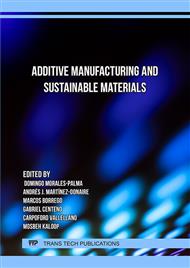[1]
I. Gibson, D. Rosen, B. Stucker. Additive Manufacturing Technologies. 3D Printing, Rapid Prototyping, and Direct Digital Manufacturing. 2nd Edition. Springer New York, NY, 2014, 498 pp.
DOI: 10.1007/978-1-4939-2113-3
Google Scholar
[2]
I. Buj-Corral, A. Tejo-Otero, and F. Fenollosa-Artés. Development of am technologies for metals in the sector of medical implants. Metals, 10(5) (2020) 686.
DOI: 10.3390/met10050686
Google Scholar
[3]
X. Xu, A. Awad, P. Robles-Martinez, S. Gaisford, A. Goyanes, and A.W. Basit. Vat photopolymerization 3D printing for advanced drug delivery and medical device applications. Journal of Controlled Release, 329 (2021) 743-757.
DOI: 10.1016/j.jconrel.2020.10.008
Google Scholar
[4]
I. Buj-Corral, H. Sanz-Fraile, A. Ulldemolins, A. Tejo-Otero, A. Domínguez-Fernández, I. Almendros and J. Otero. Characterization of 3D Printed Metal-PLA Composite Scaffolds for Biomedical Applications. Polymers, 14(13) (2022) 2754.
DOI: 10.3390/polym14132754
Google Scholar
[5]
I. Buj-Corral, A. Tejo-Otero, F. Fenollosa-Artés. Use of FDM Technology in Healthcare Applications: Recent Advances. In: Dave, H.K., Davim, J.P. (eds) Fused Deposition Modeling Based 3D Printing. Materials Forming, Machining and Tribology. Springer, Cham., 2021.
DOI: 10.1007/978-3-030-68024-4_15
Google Scholar
[6]
D.R. Bijukumar, A. Segu, J.C.M. Souza, X.J. Li, M. Barba, L.G. Mercuri, J.J. Jacobs, M.T. Mathew, Systemic and local toxicity of metal debris released from hip prostheses: A review of experimental approaches, Nanomedicine: Nanotechnology, Biology and Medicine, 14(3) (2018) 951-963.
DOI: 10.1016/j.nano.2018.01.001
Google Scholar
[7]
J. Singh, S. Singh and R. Gill. Applications of biopolymer coatings in biomedical engineering. Journal of Electrochemical Science and Engineering, 13(1) (2023) 63-81.
Google Scholar
[8]
A.A. Aldana, F. Valente, R. Dilley and B. Doyle. Development of 3D bioprinted GelMA-alginate hydrogels with tunable mechanical properties. Bioprinting, 21 (2021) e00105.
DOI: 10.1016/j.bprint.2020.e00105
Google Scholar
[9]
Xiao, X., Jiang, X., Yang, S., Lu, Z., Niu, C., Xu, Y., ... & Feng, L. Solvent evaporation induced fabrication of porous polycaprolactone scaffold via low-temperature 3D printing for regeneration medicine researches. Polymer, 217 (2021) 123436.
DOI: 10.1016/j.polymer.2021.123436
Google Scholar
[10]
Kim, J. W., Shin, K. H., Koh, Y. H., Hah, M. J., Moon, J., & Kim, H. E.. Production of poly (ε-caprolactone)/hydroxyapatite composite scaffolds with a tailored macro/micro-porous structure, high mechanical properties, and excellent bioactivity. Materials, 10(10) (2017) 1123.
DOI: 10.3390/ma10101123
Google Scholar
[11]
Jing, L., Wang, X., Liu, H., Lu, Y., Bian, J., Sun, J., & Huang, D. Zein increases the cytoaffinity and biodegradability of scaffolds 3D-printed with zein and poly (ε-caprolactone) composite ink. ACS applied materials & interfaces, 10(22) (2018) 18551-18559.
DOI: 10.1021/acsami.8b04344
Google Scholar
[12]
Choi, K., Kuhn, J. L., Ciarelli, M. J., & Goldstein, S. A. The elastic moduli of human subchondral, trabecular, and cortical bone tissue and the size-dependency of cortical bone modulus. Journal of biomechanics, 23(11) (1990) 1103-1113.
DOI: 10.1016/0021-9290(90)90003-l
Google Scholar
[13]
W. Li, A. Ghazanfari, D. McMillen, M.C. Leu, G.E. Hilmas, J. Watts. Characterization of zirconia specimens fabricated by ceramic on-demand extrusion. Ceram. Int. 44 (2018) 12245–12252.
DOI: 10.1016/j.ceramint.2018.04.008
Google Scholar
[14]
I. Buj-Corral, A. Domínguez-Fernández, A. Gómez-Gejo. Effect of printing parameters on dimensional error and surface roughness obtained in direct ink writing (DIW) processes. Materials 13 (2020) 2157.
DOI: 10.3390/ma13092157
Google Scholar
[15]
Shao, H.; Zhao, D.; Lin, T.; He, J.; Wu, J. 3D gel-printing of zirconia ceramic parts. Ceram. Int. 43 (2017) 13938–13942.
DOI: 10.1016/j.ceramint.2017.07.124
Google Scholar
[16]
Buyukaksoy, A., Kammampata, S.P., Birss, V.I. Effect of porous YSZ scaffold microstructure on the long-term performance of infiltrated Ni-YSZ anodes, Journal of Power Sources, 287 (2015) 349-358
DOI: 10.1016/j.jpowsour.2015.04.072
Google Scholar
[17]
ISO/ASTM 52900:2021. Additive manufacturing — General principles — Fundamentals and vocabulary.
Google Scholar
[18]
ISO 25178-2:2012. Geometrical product specifications (GPS) — Surface texture: Areal — Part 2: Terms, definitions and surface texture parameters
DOI: 10.3403/30154352u
Google Scholar
[19]
I. Buj-Corral, A. Bagheri, O. Petit-Rojo, 3D Printing of Porous Scaffolds with Controlled Porosity and Pore Size Values. Materials 11 (2018) 1532.
DOI: 10.3390/ma11091532
Google Scholar
[20]
Al‐Ketan, O., & Abu Al‐Rub, R. K. MSLattice: A free software for generating uniform and graded lattices based on triply periodic minimal surfaces. Material Design & Processing Communications, 3(6) (2021) e205.
DOI: 10.1002/mdp2.205
Google Scholar



